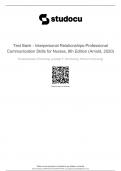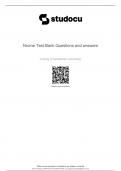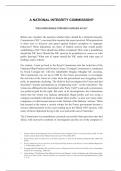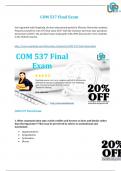FOR THE BEST EXAMS AND VERIFIED ANSWERS GURANTEED A+
Profession and have specialised in Nursing , Psychology and Humanities Courses for more information call / text zero,seven nine ,four ,nine,eight,three,five,six,seven welcome all.
THANKYOU FOR YOUR APPRECIATION.
- 1032
- 0
- 21
Community
- Followers
- Following
1053 items

Chapter 1: Theory Based Perspectives and Contemporary Dynamics Arnold: Interpersonal Relationships, 8th Edition
When describing nursing to a group of nursing students, the nursing instructor lists all of the following characteristics of nursing except a. historically nursing is as old as mankind. b. nursing was originally practiced informally by religious orders dedicated to care of the sick. c. nursing was later practiced in the home by female caregivers with no formal education. d. nursing has always been identifiable as a distinct occupation.
- Exam (elaborations)
- • 8 pages •
When describing nursing to a group of nursing students, the nursing instructor lists all of the following characteristics of nursing except a. historically nursing is as old as mankind. b. nursing was originally practiced informally by religious orders dedicated to care of the sick. c. nursing was later practiced in the home by female caregivers with no formal education. d. nursing has always been identifiable as a distinct occupation.

PA FINAL STUDY GUID
CRANIAL NERVES 1. I OLFACTORY- SMELL 2. II OPTIC- VISION/VISUAL ACUITY (SNELLEN CHART) 3. III OCULOMOTOR- EYE MOVEMENT (PERRLA) 4. IV TROCHLEAR- MOVES EYE DOWN & IN (VERTICAL) 5. V TRIGEMINAL- FACE SENSATION (TOUCH FOREHEAD, CHEEK, CLENCH JAW) 6. VI ABDUCENS- ABDUCTS THE EYE (LOOKS SIDE TO SIDE/HORIZONTAL) 7. VII FACIAL- FACIAL EXPRESSION, TASTE 8. VIII VESTIBULOCOCHLEAR- HEARING, BALANCE 9. IX GLOSSOPHARYNGEAL- TASTE, GAG REFLEX, SPEECH 10. X VAGUS- SWALLOW 11. XI ACCESSORY- SHOU
- Exam (elaborations)
- • 14 pages •
CRANIAL NERVES 1. I OLFACTORY- SMELL 2. II OPTIC- VISION/VISUAL ACUITY (SNELLEN CHART) 3. III OCULOMOTOR- EYE MOVEMENT (PERRLA) 4. IV TROCHLEAR- MOVES EYE DOWN & IN (VERTICAL) 5. V TRIGEMINAL- FACE SENSATION (TOUCH FOREHEAD, CHEEK, CLENCH JAW) 6. VI ABDUCENS- ABDUCTS THE EYE (LOOKS SIDE TO SIDE/HORIZONTAL) 7. VII FACIAL- FACIAL EXPRESSION, TASTE 8. VIII VESTIBULOCOCHLEAR- HEARING, BALANCE 9. IX GLOSSOPHARYNGEAL- TASTE, GAG REFLEX, SPEECH 10. X VAGUS- SWALLOW 11. XI ACCESSORY- SHOU

NRCME Test Bank Questions and answers
1. Which of the following is a requirement for drivers with a diabetes exemption? A) Possess a rapidly absorbable form of glucose while driving B) Self—monitor blood glucose one hour before driving and at least once every 2 hours while driving C) Plan to submit blood glucose monitoring logs every 6 months D) Maintain a Hemoglobin A1C value less than 7 - A.
- Exam (elaborations)
- • 71 pages •
1. Which of the following is a requirement for drivers with a diabetes exemption? A) Possess a rapidly absorbable form of glucose while driving B) Self—monitor blood glucose one hour before driving and at least once every 2 hours while driving C) Plan to submit blood glucose monitoring logs every 6 months D) Maintain a Hemoglobin A1C value less than 7 - A.

Test Bank Instructors
1. In pursuing a global marketing strategy a firm may: (a) Standardize its product (b) Use a consistent brand name (c) Allow each country manager full autonomy over local marketing strategy (d) (a) and (b) (e) (b) and (
- Exam (elaborations)
- • 38 pages •
1. In pursuing a global marketing strategy a firm may: (a) Standardize its product (b) Use a consistent brand name (c) Allow each country manager full autonomy over local marketing strategy (d) (a) and (b) (e) (b) and (

Version: 6
Which statement is correct when considering the right to privacy under Article 8 of the European Convention on Human Rights (ECHR)? A. The right to privacy is an absolute right B. The right to privacy has to be balanced against other rights under the ECHR C. The right to freedom of expression under Article 10 of the ECHR will always override the right to privacy D. The right to privacy protects the right to hold opinions and to receive and impart ideas with
- Exam (elaborations)
- • 5 pages •
Which statement is correct when considering the right to privacy under Article 8 of the European Convention on Human Rights (ECHR)? A. The right to privacy is an absolute right B. The right to privacy has to be balanced against other rights under the ECHR C. The right to freedom of expression under Article 10 of the ECHR will always override the right to privacy D. The right to privacy protects the right to hold opinions and to receive and impart ideas with

LECTURES 17-20 AND RELEVANT READINGS QUESTIONS
LECTURE 18 1. What are the three main questions of this lecture? 2. Draw a diagram of sexual and reproductive systems. 3. What is Darwin’s question about sexual reproduction? 4. What are two examples of shifting sexual systems? 5. What are the definitions of asexual and sexual reproduction? 6. What are the costs of sex? (6) 7. Expand on two. 8. What are the advantages of sex? (2) 9. Expand on the two p
- Exam (elaborations)
- • 5 pages •
LECTURE 18 1. What are the three main questions of this lecture? 2. Draw a diagram of sexual and reproductive systems. 3. What is Darwin’s question about sexual reproduction? 4. What are two examples of shifting sexual systems? 5. What are the definitions of asexual and sexual reproduction? 6. What are the costs of sex? (6) 7. Expand on two. 8. What are the advantages of sex? (2) 9. Expand on the two p

HESI Maternal and Child Health Nursing
1. When getting down to two answers, choose the assessment answer (assess, collect, auscultate, monitor, palpate) over the intervention except in an emergency or distress situation. If one answer has an absolute, discard it. Give priority to answers that deal directly to the patient‟s body, not the machines/equipments. 2. Key words are very important. Avoid answers with absolutes for example: always, never, must, etc. 3. With lower amputations patient is placed in prone position. ...
- Exam (elaborations)
- • 44 pages •
1. When getting down to two answers, choose the assessment answer (assess, collect, auscultate, monitor, palpate) over the intervention except in an emergency or distress situation. If one answer has an absolute, discard it. Give priority to answers that deal directly to the patient‟s body, not the machines/equipments. 2. Key words are very important. Avoid answers with absolutes for example: always, never, must, etc. 3. With lower amputations patient is placed in prone position. ...

A NATIONAL INTEGRITY COMMISSION?
n recent years, in New South Wales we have seen: a Minister of the Crown gaoled for bribery; an inquiry into a second, and indeed a third, former Minister for alleged corruption; the former Chief Stipendiary Magistrate gaoled for perverting the course of justice; a former Commissioner of Police in the courts on a criminal charge; the former Deputy Commissioner of Police charged with
- Exam (elaborations)
- • 22 pages •
n recent years, in New South Wales we have seen: a Minister of the Crown gaoled for bribery; an inquiry into a second, and indeed a third, former Minister for alleged corruption; the former Chief Stipendiary Magistrate gaoled for perverting the course of justice; a former Commissioner of Police in the courts on a criminal charge; the former Deputy Commissioner of Police charged with

Technical Guide for Latent GOLD 5.1: Basic, Advanced, and Syntax1
2.1 Probability Structure . . . . . . . . . . . . . . . . . . . . . . . 8 2.2 Conditional Distributions . . . . . . . . . . . . . . . . . . . . . 10 2.2.1 Nominal and ordinal dependent variables . . . . . . . . 10 2.2.2 Continuous dependent variables . . . . . . . . . . . . . 11 2.2.3 Poisson counts . . . . . . . . . . . . . . . . . . . . . . 12 2.2.4 Binomial counts . . . . . . . . . . . . . . . . . . . . . . 13 2.2.5 Latent variables . . . . . . . . . . . . . . . . . . . . . . 15 2.3 Ty...
- Exam (elaborations)
- • 167 pages •
2.1 Probability Structure . . . . . . . . . . . . . . . . . . . . . . . 8 2.2 Conditional Distributions . . . . . . . . . . . . . . . . . . . . . 10 2.2.1 Nominal and ordinal dependent variables . . . . . . . . 10 2.2.2 Continuous dependent variables . . . . . . . . . . . . . 11 2.2.3 Poisson counts . . . . . . . . . . . . . . . . . . . . . . 12 2.2.4 Binomial counts . . . . . . . . . . . . . . . . . . . . . . 13 2.2.5 Latent variables . . . . . . . . . . . . . . . . . . . . . . 15 2.3 Ty...

COM 537 Final Exam
A criticism of social media is that it is only available to the media savvy. contributes to the decline in writing and language skills. leads to separation of the haves and have-nots. leads to information overload
- Exam (elaborations)
- • 10 pages •
A criticism of social media is that it is only available to the media savvy. contributes to the decline in writing and language skills. leads to separation of the haves and have-nots. leads to information overload
